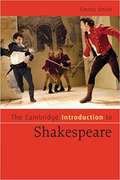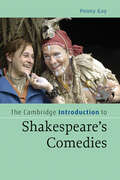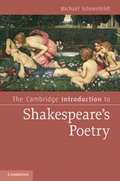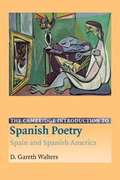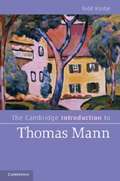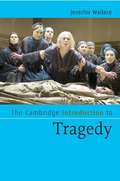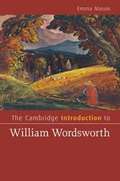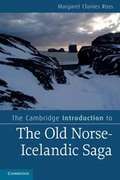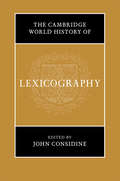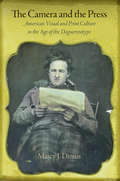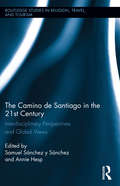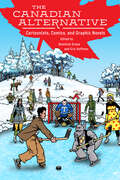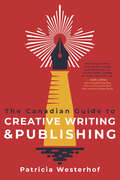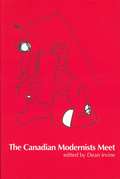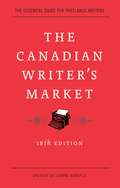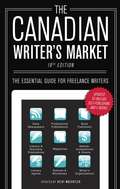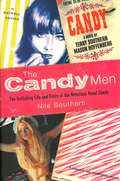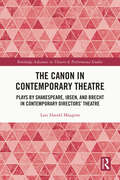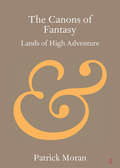- Table View
- List View
The Cambridge Introduction to Shakespeare
by Emma SmithThis lively and innovative 2007 introduction to Shakespeare promotes active engagement with the plays, rather than recycling factual information. Covering a range of texts, it is divided into seven subject-based chapters: Character; Performance; Texts; Language; Structure; Sources and History, and it does not assume any prior knowledge. Instead, it develops ways of thinking and provides the reader with resources for independent research through the 'Where next?' sections at the end of each chapter. The book draws on up-to-date scholarship without being overwhelmed by it, and unlike other introductory guides to Shakespeare it emphasizes that there is space for new and fresh thinking by students and readers, even on the most-studied and familiar plays.
The Cambridge Introduction to Shakespeare's Comedies
by Penny GayWhy did theatre audiences laugh in Shakespeare's day? Why do they still laugh now? What did Shakespeare do with the conventions of comedy that he inherited, so that his plays continue to amuse and move audiences? What do his comedies have to say about love, sex, gender, power, family, community, and class? What place have pain, cruelty, and even death in a comedy? Why all those puns? In a survey that travels from Shakespeare's earliest experiments in farce and courtly love-stories to the great romantic comedies of his middle years and the mould-breaking experiments of his last decade's work, this book addresses these vital questions. Organised thematically, and covering all Shakespeare's comedies from the beginning to the end of his career, it provides readers with a map of the playwright's comic styles, showing how he built on comedic conventions as he further enriched the possibilities of the genre.
The Cambridge Introduction to Shakespeare's Poetry
by Michael SchoenfeldtShakespeare's poems, aside from the enduring appeal of the Sonnets, are much less familiar today than his plays, despite being enormously popular in his lifetime. This Introduction celebrates the achievement of Shakespeare as a poet, providing students with ways of understanding and enjoying his remarkable poems. It honours the aesthetic and intellectual complexity of the poems without making them seem unapproachably complicated, outlining their exquisite pleasures and absorbing enigmas. Schoenfeldt suggests that today's readers are better able to analyze aspects of the poems that were formerly ignored or the source of scandal - the articulation of a fervent same-sex love, for example, or the incipient racism inherent in a hierarchy of light and dark. By engaging closely with Shakespeare's major poems - Venus and Adonis, Lucrece, The Phoenix and the Turtle, the Sonnets and A Lover's Complaint - the Introduction demonstrates how much these extraordinary poems still have to say to us.
The Cambridge Introduction to Spanish Poetry
by D. WaltersThe Cambridge Introduction to Spanish Poetry comprises an extended survey of poetry written in Spanish from the Middle Ages to the present day, including both Iberian and Latin American writing. This volume offers a non-chronological approach to the subject in order to highlight the continuity and persistence of genres and forms (epic, ballad, sonnet) and of themes and motifs (love, religious and moral poetry, satirical and pure poetry). It also supplies a thorough examination of the various interactions between author, text and reader. Containing abundant quotation, it gives a refreshing introduction to an impressive and varied body of poetry from two continents, and is an accessible and wide-ranging reference-work, designed specifically for use on undergraduate and taught graduate courses. The most comprehensive work of its kind available, it will be an invaluable resource for students and teachers alike.
The Cambridge Introduction to Thomas Mann
by Todd KontjeNobel Prize-winner Thomas Mann (1875-1955) is not only one of the leading German novelists of the twentieth century, but also one of the few to transcend national and language boundaries to achieve major stature in the English-speaking world. Famous from the time that he published his first novel in 1901, Mann became an iconic figure, seen as the living embodiment of German national culture. Leading scholar Todd Kontje provides a succinct introduction to Mann's life and work, discussing key moments in Mann's personal life and his career as a public intellectual, and giving readers a sense of why he is considered such an important - and controversial - writer. At the heart of the book is an informed appreciation of Mann's great literary achievements, including the novel The Magic Mountain and the haunting short story Death in Venice.
The Cambridge Introduction to Toni Morrison
by Tessa RoynonToni Morrison has written some of the most significant and demanding fiction of the modern age. Her dazzling depictions of African-American experience are studied in high schools and colleges, debated in the media, and analyzed by scholars at an astounding rate. This Introduction offers readers a guide to the world of Morrison in all its complexity, from her status as a key player on the global intellectual stage, to her unique perspective on American history and her innovative narrative techniques. Covering every novel from The Bluest Eye to A Mercy, Tessa Roynon combines close readings with critical insights into Morrison's other creative work, such as short stories, libretto and song lyrics, and unpublished pieces for performance. Chapters also highlight the significance of Morrison's non-fiction, including her groundbreaking work of literary criticism, Playing in the Dark, as well as her many essays, speeches, and interviews. Lively and accessibly written, Roynon's insightful text is ideal for readers approaching Morrison for the first time as well as those familiar with her work.
The Cambridge Introduction to Tragedy
by Jennifer WallaceTragedy is the art-form created to confront the most difficult experiences we face: death, loss, injustice, thwarted passion, despair. From ancient Greek theatre up to the most recent plays, playwrights have found, in tragic drama, a means to seek explanation for disaster. But tragedy is also a word we continually encounter in the media, to denote an event which is simply devastating in its emotional power. This introduction explores the relationship between tragic experience and tragic representation. After giving an overview of the tragic theatre canon - including chapters on the Greeks, Shakespeare, Ibsen, Chekhov, post-colonial drama, and Beckett - it also looks at the contribution which philosophers have brought to this subject, before ranging across other art-forms and areas of debate. The book is unique in its chronological range, and brings a wide spectrum of examples, from both literature and life, into the discussion of this emotional and frequently controversial subject.
The Cambridge Introduction to Travel Writing
by Tim YoungsCritics have long struggled to find a suitable category for travelogues. From its ancient origins to the present day, the travel narrative has borrowed elements from various genres - from epic poetry to literary reportage - in order to evoke distant cultures and exotic locales, and sometimes those closer to hand. Tim Youngs argues in this lucid and detailed Introduction that travel writing redefines the myriad genres it comprises and is best understood on its own terms. To this end, Youngs surveys some of the most celebrated travel literature from the medieval period until the present, exploring themes such as the quest motif, the traveler's inner journey, postcolonial travel, and issues of gender and sexuality. The text culminates in a chapter on twenty-first-century travel writing and offers predictions about future trends in the genre, making this Introduction an ideal guide for today's students, teachers, and travel writing enthusiasts.
The Cambridge Introduction to Victorian Poetry
by Linda K. HughesVictorian poetry was read and enjoyed by a much larger audience than is sometimes thought. Publication in widely-circulating periodicals, reprinting in book reviews, and excerpting in novels and essays ensured that major poets such as Tennyson, Browning, Hardy and Rossetti were household names, and they remain popular today. The Cambridge Introduction to Victorian Poetry provides an accessible overview of British poetry from 1830 to 1901, paying particular attention to its role in mass media print culture. Designed to interest both students and scholars, the book traces lively dialogues between poets and explains poets' choices of form, style and language. It also demonstrates poetry's relevance to Victorian debates on science, social justice, religion, imperialism, and art. Featuring a glossary of literary terms, a guide to further reading, and two examples of close readings of Victorian poems, this introduction is the ideal starting-point for the study of verse in the nineteenth century.
The Cambridge Introduction to William Wordsworth
by Emma MasonWilliam Wordsworth is the most influential of the Romantic poets, and remains widely popular, even though his work is more complex and more engaged with the political, social and religious upheavals of his time than his reputation as a 'nature poet' might suggest. Outlining a series of contexts - biographical, historical and literary - as well as critical approaches to Wordsworth, this Introduction offers students ways to understand and enjoy Wordsworth's poetry and his role in the development of Romanticism in Britain. Emma Mason offers a completely up-to-date summary of criticism on Wordsworth from the Romantics to the present and an annotated guide to further reading. With definitions of technical terms and close readings of individual poems, Wordsworth's experiments with form are fully explained. This concise book is the ideal starting point for studying Lyrical Ballads, The Prelude, and the major poems as well as Wordsworth's lesser known writings.
The Cambridge Introduction to the Eighteenth-Century Novel
by April LondonIn the eighteenth century, the novel became established as a popular literary form all over Europe. Britain proved an especially fertile ground, with Defoe, Fielding, Richardson and Burney as early exponents of the novel form. The Cambridge Introduction to the Eighteenth-Century Novel considers the development of the genre in its formative period in Britain. Rather than present its history as a linear progression, April London gives an original new structure to the field, organizing it through three broad thematic clusters – identity, community and history. Within each of these themes, she explores the central tensions of eighteenth-century fiction: between secrecy and communicativeness, independence and compliance, solitude and family, cosmopolitanism and nation-building. The reader will gain a thorough understanding of both prominent and lesser-known novels and novelists, key social and literary contexts, the tremendous formal variety of the early novel and its growth from a marginal to a culturally central genre.
The Cambridge Introduction to the Old Norse-Icelandic Saga
by Margaret Clunies RossThe medieval Norse-Icelandic saga is one of the most important European vernacular literary genres of the Middle Ages. This Introduction to the saga genre outlines its origins and development, its literary character, its material existence in manuscripts and printed editions, and its changing reception from the Middle Ages to the present time. Its multiple sub-genres - including family sagas, mythical-heroic sagas and sagas of knights - are described and discussed in detail, and the world of medieval Icelanders is powerfully evoked. The first general study of the Old Norse-Icelandic saga to be written in English for some decades, the Introduction is based on up-to-date scholarship and engages with current debates in the field. With suggestions for further reading, detailed information about the Icelandic literary canon, and a map of medieval Iceland, this book is aimed at students of medieval literature and assumes no prior knowledge of Scandinavian languages.
The Cambridge World History of Lexicography
by John ConsidineA dictionary records a language and a cultural world. This global history of lexicography is the first survey of all the dictionaries which humans have made, from the ancient civilizations of Mesopotamia, Egypt, China, India, and the Greco-Roman world, to the contemporary speech communities of every inhabited continent. Their makers included poets and soldiers, saints and courtiers, a scribe in an ancient Egyptian 'house of life' and a Vietnamese queen. Their physical forms include Tamil palm-leaf manuscripts and the dictionary apps which are supporting endangered Australian languages. Through engaging and accessible studies, a diverse team of leading scholars provide fascinating insight into the dictionaries of hundreds of languages, into the imaginative worlds of those who used or observed them, and into a dazzling variety of the literate cultures of humankind.
The Camera and the Press
by Marcy J. DiniusBefore most Americans ever saw an actual daguerreotype, they encountered this visual form through written descriptions, published and rapidly reprinted in newspapers throughout the land. In The Camera and the Press, Marcy J. Dinius examines how the first written and published responses to the daguerreotype set the terms for how we now understand the representational accuracy and objectivity associated with the photograph, as well as the democratization of portraiture that photography enabled.Dinius's archival research ranges from essays in popular nineteenth-century periodicals to daguerreotypes of Americans, Liberians, slaves, and even fictional characters. Examples of these portraits are among the dozens of illustrations featured in the book. The Camera and the Press presents new dimensions of Nathaniel Hawthorne's The House of the Seven Gables, Herman Melville's Pierre, Harriet Beecher Stowe's Uncle Tom's Cabin, and Frederick Douglass's The Heroic Slave. Dinius shows how these authors strategically incorporated aspects of daguerreian representation to advance their aesthetic, political, and social agendas. By recognizing print and visual culture as one, Dinius redefines such terms as art, objectivity, sympathy, representation, race, and nationalism and their interrelations in nineteenth-century America.
The Camino de Santiago in the 21st Century: Interdisciplinary Perspectives and Global Views (Routledge Studies in Pilgrimage, Religious Travel and Tourism)
by Samuel Sánchez y Sánchez Annie HespThe Spanish Camino de Santiago, a pilgrimage rooted in the Medieval period and increasingly active today, has attracted a growing amount of both scholarly and popular attention. With its multiple points of departure in Spain and other European countries, its simultaneously secular and religious nature, and its international and transhistorical population of pilgrims, this particular pilgrimage naturally invites a wide range of intellectual inquiry and scholarly perspectives. This volume fills a gap in current pilgrimage studies, focusing on contemporary representations of the Camino de Santiago. Complementing existing studies of the Camino’s medieval origins, it situates the Camino as a modern experience and engages interdisciplinary perspectives to present a theoretical framework for exploring the most central issues that concern scholars of pilgrimage studies today. Contributors explore the contemporary meaning of the Camino through an interdisciplinary lens that reflects the increasing permeability between academic disciplines and fields, bringing together a wide range of theoretical and critical perspectives (cultural studies, literary studies, globalization studies, memory studies, ethnic studies, postcolonial studies, cultural geographies, photography, and material culture). Chapters touch on a variety of genres (blogs, film, graphic novels, historical novels, objects, and travel guides), and transnational perspectives (Australia, the Arab world, England, Spain, and the United States).
The Canadian Alternative: Cartoonists, Comics, and Graphic Novels
by Dominick Grace and Eric HoffmanContributions by Jordan Bolay, Ian Brodie, Jocelyn Sakal Froese, Dominick Grace, Eric Hoffman, Paddy Johnston, Ivan Kocmarek, Jessica Langston, Judith Leggatt, Daniel Marrone, Mark J. McLaughlin, Joan Ormrod, Laura A. Pearson, Annick Pellegrin, Mihaela Precup, Jason Sacks, and Ruth-Ellen St. OngeThis overview of the history of Canadian comics explores acclaimed as well as unfamiliar artists. Contributors look at the myriad ways that English-language, Francophone, Indigenous, and queer Canadian comics and cartoonists pose alternatives to American comics, to dominant perceptions, even to gender and racial categories.In contrast to the United States' melting pot, Canada has been understood to comprise a social, cultural, and ethnic mosaic, with distinct cultural variation as part of its identity. This volume reveals differences that often reflect in highly regional and localized comics such as Paul MacKinnon's Cape Breton-specific Old Trout Funnies, Michel Rabagliati's Montreal-based Paul comics, and Kurt Martell and Christopher Merkley's Thunder Bay-specific zombie apocalypse.The collection also considers some of the conventionally "alternative" cartoonists, namely Seth, Dave Sim, and Chester Brown. It offers alternate views of the diverse and engaging work of two very different Canadian cartoonists who bring their own alternatives into play: Jeff Lemire in his bridging of Canadian/US and mainstream/alternative sensibilities and Nina Bunjevac in her own blending of realism and fantasy as well as of insider/outsider status. Despite an upsurge in research on Canadian comics, there is still remarkably little written about most major and all minor Canadian cartoonists. This volume provides insight into some of the lesser-known Canadian alternatives still awaiting full exploration.
The Canadian Guide to Creative Writing and Publishing
by Patricia WesterhofThe essential guide for Canadian writers seeking to have their work published today.How do you get your writing published in Canada? What are the industry standards for publishable work and how do you reach them? This lively, practical guide shows you how to think more creatively, cultivate a strong writing voice, and make your sentences powerful. It explains the elements of style and offers writing prompts to help you apply what you learn. It gives strategies for finding critique partners and beta readers and for getting useful feedback before you send your drafts to agents or editors. The chapters are packed with up-to-date information about the publishing industry, including how to find an agent, how to submit manuscripts to literary journals, how to query independent presses, and how to apply for writing grants. The Canadian Guide to Creative Writing & Publishing confidently leads you through the process of polishing your writing and finding an audience for your work.
The Canadian Modernists Meet (Reappraisals: Canadian Writers)
by Dean IrvineThe Canadian Modernists Meet is a collection of new critical essays on major and rediscovered Canadian writers of the early to mid-twentieth century. F.R. Scott's well-known poem 'The Canadian Authors Meet' sets the theme for the volume: a revisiting of English Canada's formative movements in modernist poetry, fiction, and drama. As did Scott's poem, Dean Irvine's collection raises questions - about modernism and antimodernism, nationalism and antinationalism, gender and class, originality and influence - that remain central to contemporary research on early to mid-twentieth-century English Canadian literature.The Canadian Modernists Meetis the first collection of its kind: a gathering of texts by literary critics, textual editors, biographers, literary historians, and art historians whose collective research contributes to the study of modernism in Canada. The collection stages a major reassessment of the origins and development of modernist literature in Canada, its relationship to international modernist literature, its regional variations, its gender and class inflections, and its connections to visual art, architecture, and film. It presents a range of scholarly perspectives, drawing upon the multidisciplinarity that characterizes the international field of modernist studies.
The Canadian Style: A Guide to Writing and Editing
by Dundurn Press Limited Public Works Government Services Canada Translation BureauThe revised edition of The Canadian Style is an indispensable language guide for editors, copywriters, students, teachers, lawyers, journalists, secretaries and business people – in fact, anyone writing in the English language in Canada today. It provides concise, up-to-date answers to a host of questions on abbreviations, hyphenation, spelling, the use of capital letters, punctuation and frequently misused or confused words. It deals with letter, memo and report formats, notes, indexes and bibliographies, and geographical names. It also gives techniques for writing clearly and concisely, editing documents and avoiding stereotyping in communications. There is even an appendix on how to present French words in an English text.
The Canadian Writer's Market, 18th Edition
by Joanna KaraplisThe essential guide for freelance writers, now completely updated and revised. The Canadian Writer's Market is the authority on who publishes what and how best to bring your work to their attention. It offers practical advice on everything from manuscript preparation to copyright law, from information on pay rates to writers' workshops. This useful guide also includes comprehensive and up-to-date listings for: comsumer magazines; literary and scholarly journals; trade, business, and professional publications; daily newspapers; book publishers; literary agents; awards, competitions, and grants; writers' organizations and support agencies; writers' workshops, courses, and retreats.
The Canadian Writer's Market, 19th Edition: The Essential Guide for Freelance Writers
by Heidi WaechtlerThe essential guide for freelance writers, now completely updated and revised. The Canadian Writer's Market is the authority on who publishes what and how best to bring your work to their attention. It offers practical advice on everything from manuscript preparation to copyright law, from information on pay rates to writers' workshops. This useful guide also includes comprehensive and up-to-date listings for: consumer magazines; literary and scholarly journals; trade, business, and professional publications; daily newspapers; book publishers; literary agents; awards, competitions, and grants; writers' organizations and support agencies; writers' workshops, courses, and retreats.From the Trade Paperback edition.
The Candy Men
by Nile SouthernA Rabelaisian satire loosely based on Voltaire's Candide, Terry Southern and Mason Hoffenberg's Candy became one of the most famous novels of the tumultuous 1960's. Detailing its humble beginnings in Paris through its agonizing three-year writing gestation (often on paper napkins, lost or destroyed) and the authors' wily business dealings first with French-based publisher Maurice Girodias, then Putnam is America, this book follows with unblinking scrutiny Candy's underground (then mainstream) success, its blatant piracy, its legal shenanigans, and its all-star movie flop. Replete with deceptions and self-deceptions, midnight dope runs, and general pandemonium, THE CANDY MEN is as much fun to read as the original novel itself. And far more instructive.
The Canon in Contemporary Theatre: Plays by Shakespeare, Ibsen, and Brecht in Contemporary Directors’ Theatre (ISSN)
by Lars Harald MaagerøThis book explores the relationship between contemporary theatre, particularly contemporary theatre directors, and the dramatic canon of plays.Through focusing on productions of plays by three canonical playwrights (Shakespeare, Ibsen, and Brecht) by eight contemporary European directors (Michael Buffong, Joe Hill-Gibbins, and Emma Rice from the UK, Christopher Rüping from Germany, Thorleifur Örn Arnarsson from Iceland, and Kjeriski Hom, Alexander Mørk-Eidem, and Sigrid Strøm Reibo from Norway) the book investigates why and how the theatre continues to engage with canonical plays. In particular, the book questions the political and cultural implications of theatrical reproductions of the literary canon. Drawing on Chantal Mouffe’s theories of agonism and ‘critical art,’ the book investigates whether theatrical reproduction of the canon always reconstitutes the hegemonic values and ideologies of the canon, or whether theatrical interventions in the canon can challenge such values and ideologies, and thereby also challenge the dominant ideologies and hegemonies of contemporary culture and society.This study will be of great interest to academics and students in drama and theatre, particularly those who work with theatre in the twenty-first century, directors’ theatre, and the political impact of theatre.
The Canongate Burns: The Complete Poems And Songs Of Robert Burns (Canongate Classics #24)
by Robert BurnsThis &“magnificent and authoritative work&” presents the complete verse of Scotland&’s National Bard with extensive textual and historical notes (Colm Toibin, The Independent, UK). Best known for poems such as &“A Red, Red Rose&” and &“Ae Fond Kiss,&” and for the song &“Auld Lang Synge,&” which is sung around the world every New Years&’ Eve, Robert Burns was one of the most important poets of the 18th century. A major influence on the Romantic poetry movement, Burns is still beloved across Scotland, with Burns Night celebrated every January 25th. This complete volume of the writer&’s poetry and songs includes previously unpublished pieces, draws on extensive scholarship and Burn&’s own letters, and offers supplemental information about his life, early hardships, political beliefs, and literary contexts. An extensive glossary of Scots words is included.&“A very fine edition, and the long introduction, which sets out to clear the tangled banks, is alone worth the cover price.&”—The Scotsman, UK
The Canons of Fantasy: Lands of High Adventure (Elements in Publishing and Book Culture)
by Patrick MoranDespite publishing endeavours such as the Ballantine Adult Fantasy Series in the 1970s and Fantasy Masterworks in the early 2000s, the canon of modern fantasy is still very much in flux. This Element examines four key questions raised by the prospect of a fantasy canon: the way in which canon and genre influence each other; the overwhelming presence of Tolkien in any discussion of the classics of fantasy; the multi-media and transmedia nature of the field; and the push for a more inclusive and diverse canon.
